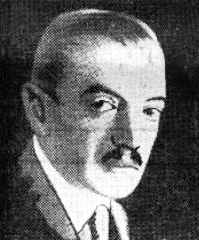Ivo Tartaglia
This article needs additional citations for verification. (October 2010) |
Ivo Tartaglia | |
|---|---|
 | |
| 32nd Mayor of Split | |
| In office 1918–1928 | |
| Preceded by | Josip Smodlaka |
| Succeeded by | Petar Bonetti |
| 1st Ban of Littoral Banovina | |
| In office 1929–1932 | |
| Preceded by | Position established |
| Succeeded by | Josip Jablanović |
| Personal details | |
| Born | 6 February 1880 Split, Kingdom of Dalmatia, Austria-Hungary |
| Died | 3 April 1949 (aged 69) Lepoglava, PR Croatia, FPR Yugoslavia |
Dr. Ivo Tartaglia (Croatian pronunciation: [ǐːʋo tartâʎa]; 5 February 1880 – 3 April 1949) was "a committed anti-fascist",[1] a former ban (governor) of the province of Littoral Banovina (Croatian/Serbo-Croat: Primorska banovina),[1] and the 32nd mayor of Split, Yugoslavia (in what is today known as Croatia).
Biography
[edit]Tartaglia was born in Split in 1880. He grew up in a noble family with Dalmatian Italian roots.
He was known as a patron, art lover, bibliophile, and collector. On 29 May 1928, the Split Town Hall decided to form the Gallery of Fine Arts, but due to a lack of funds, the Gallery did not open until 1 December 1931 (as the Gallery of Fine Arts of the Coastal Province). Tartaglia's bequest added more than 300 works to the Gallery's holdings.[2]
Following the death of Juraj Biankini, Tartaglia became the president of Jadranska straža.[3]
In June 1948, Tartaglia was put on trial in Split, along with others, on charges of having expressed pro-Mussolini sentiments and otherwise undermining the government of the Socialist Federal Republic of Yugoslavia. (Tartaglia had opposed Mussolini during World War II.) He was sentenced to seven years at hard labor, plus the loss of his civic rights for two years after that, as well as having all of his property confiscated.[1]
Tartaglia died in 1949 at the Lepoglava prison.
Mayor of Split
[edit]He was responsible for building the Ličke railways in 1925, which connected peninsular Split to the mainland. At the time, Yugoslavia would not finance the construction of railways. Tartaglia enlisted entrepreneurs and savings banks to support the project. During his incumbency, the zoo opened, airports were expanded and modernized, and a meteorological station was built.
Ban of Littoral Banovina
[edit]Tartaglia was the ban of Littoral Banovina from 9 October 1929 to June 1932.[4]
The ban started a series of projects in Littoral Banovina, building hospitals in Biograd, draining wetlands, improvement of agriculture, etc.
Between 1929 and 1932, the ban of Littoral Banovina was based in Split.
References
[edit]- ^ a b c Ramet, Sabrina P. (2006). The Three Yugoslavias: state-building and legitimization, 1918–2005. Woodrow Wilson Center Press Series. Indiana University Press. p. 171. ISBN 978-0-253-34656-8. Retrieved 2010-10-06.
- ^ "History of the Gallery". Galerija : Umjetnina Split. Split, Croatia: Gallery of Fine Arts. Archived from the original on 2011-06-14. Retrieved 2010-10-06.
- ^ Tchoukarine, Igor (2019). "To serve the King, the State and the people: the Adriatic Guard's ambiguous position in interwar Yugoslavia". European Review of History. 26 (1). Abingdon-on-Thames: Taylor & Francis: 121–140:122–123. doi:10.1080/13507486.2018.1468737. ISSN 1350-7486.
- ^ Cahoon, Ben (2000). "Croatia". World Statesmen.org. Retrieved 2010-10-06.
